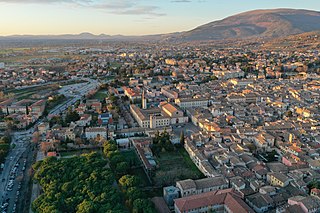
Giovanni di Pietro di Bernardone, known as Francis of Assisi, was an Italian mystic, poet, and Catholic friar who founded the religious order of the Franciscans. Inspired to lead a Christian life of poverty, he became a beggar and itinerant preacher.

Assisi is a town and commune of Italy in the Province of Perugia in the Umbria region, on the western flank of Monte Subasio.

Foligno is an ancient town of Italy in the province of Perugia in east central Umbria, on the Topino river where it leaves the Apennines and enters the wide plain of the Clitunno river system. It is located 40 kilometres south-east of Perugia, 10 km (6 mi) north-north-west of Trevi and 6 km (4 mi) south of Spello.

Bettona is an ancient town and comune of Italy, in the province of Perugia in central Umbria at the northern edge of the Colli Martani range. It is 5 km (3 mi) E of Torgiano and 12 km (7 mi) SW of Assisi. It is one of I Borghi più belli d'Italia. Passaggio, Colle, and Cerreto are frazioni of the comune.

Nocera Umbra is a town and comune in the province of Perugia, Italy, 15 kilometers north of Foligno, at an altitude of 520 m above sea-level. The comune, covering an area of 157.19 km2, is one of the largest in Umbria. It is one of I Borghi più belli d'Italia.

Constantius of Perugia is one of the patron saints of Perugia, Italy.

The Italian Catholic Church, or Catholic Church in Italy, is part of the worldwide Catholic Church in communion with the Pope in Rome, under the Conference of Italian Bishops. The pope serves also as Primate of Italy and Bishop of Rome. In addition to the Italian Republic, two other sovereign states are included in Italian dioceses: San Marino and Vatican City. There are 225 dioceses in the Catholic Church in Italy, see further in this article and in the article List of Catholic dioceses in Italy.

Assisi Cathedral, dedicated to San Rufino, is a major church in Assisi, Italy. This stately church in Umbrian Romanesque style was the third church built on the same site to contain the remains of bishop Rufinus of Assisi, martyred in the 3rd century. The construction was started in 1140 to the designs by Giovanni da Gubbio, as attested by the wall inscription visible inside the apse. He may be the same Giovanni who designed the rose-window on the façade of Santa Maria Maggiore in 1163.

Joseph of Leonessa, OFMCap, (1556 – February 4, 1612) was an Italian Capuchin friar and is a saint of the Catholic Church commemorated on February 4.

Sabinus of Spoleto was a bishop in the early Christian church who resisted the Diocletianic Persecution and was martyred.

Felician(us) of Foligno is the patron saint of Foligno.

The Diocese of Nocera Umbra was a Catholic diocese in Umbria, Italy.

The Diocese of Foligno is a Latin Church ecclesiastical territory or diocese of the Catholic Church in Umbria, Italy. It is a suffragan diocese in the ecclesiastical province of the metropolitan Archdiocese of Perugia-Città della Pieve.

The Diocese of Assisi-Nocera Umbra-Gualdo Tadino is a Latin diocese of the Catholic Church in Umbria, has existed since 1986. In that year the historic Diocese of Assisi, known as the birthplace of Francis of Assisi, was combined with the Diocese of Nocera Umbra-Gualdo Tadino. The diocese is a suffragan of the Archdiocese of Perugia-Città della Pieve.

Foligno Cathedral is a Catholic cathedral situated on the Piazza della Repubblica in the center of Foligno, Italy. The cathedral, built on the site of an earlier basilica, is dedicated to the patron saint of the city, the martyr Felician of Foligno, who was buried here in 251 AD. It is the seat of the Bishop of Foligno. It contains the cathedra for the Diocese of Foligno.

Dono Doni, also known as Adone Doni or Dono dei Doni (1505-1575) was an Italian painter of the Renaissance period active mainly in Umbria.

Chiesa di San Francesco is a late-Romanesque- early Gothic architecture, Roman Catholic church located on Via Ippolito Scalza in the southern ridge of the historic center of Orvieto, Umbria, Italy. It was consecrated in 1266. It belongs to the Roman Catholic Diocese of Orvieto-Todi. The adjacent monastery since 2009 is the home to the New Public Library Luigi Fumi, moved here from its prebious home in piazza Febei.

Gualdo Tadino Cathedral is a Roman Catholic cathedral in Gualdo Tadino in Umbria, Italy, dedicated to Saint Benedict of Nursia. Formerly a Benedictine abbey church, it became a cathedral in 1915, and is now a co-cathedral in the diocese of Assisi-Nocera Umbra-Gualdo Tadino.

San Fortunato is a Gothic- and Renaissance-style, Roman Catholic church located on Piazza Umberto I #6 in the historic center of Todi, province of Perugia, region of Umbria, Italy.

The church of Saint Maria Assunta is a Catholic parish church in Nocera Umbra, in Umbria, and co-cathedral of the diocese of Assisi-Nocera Umbra-Gualdo Tadino.




















